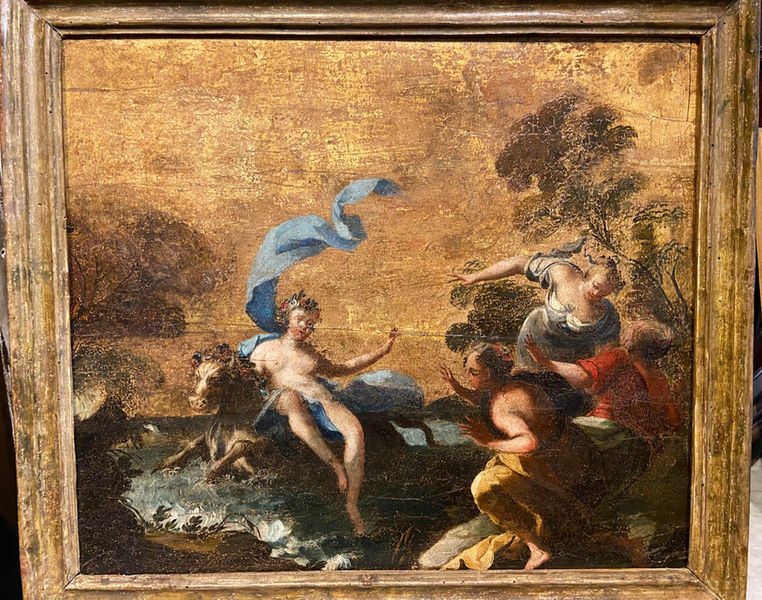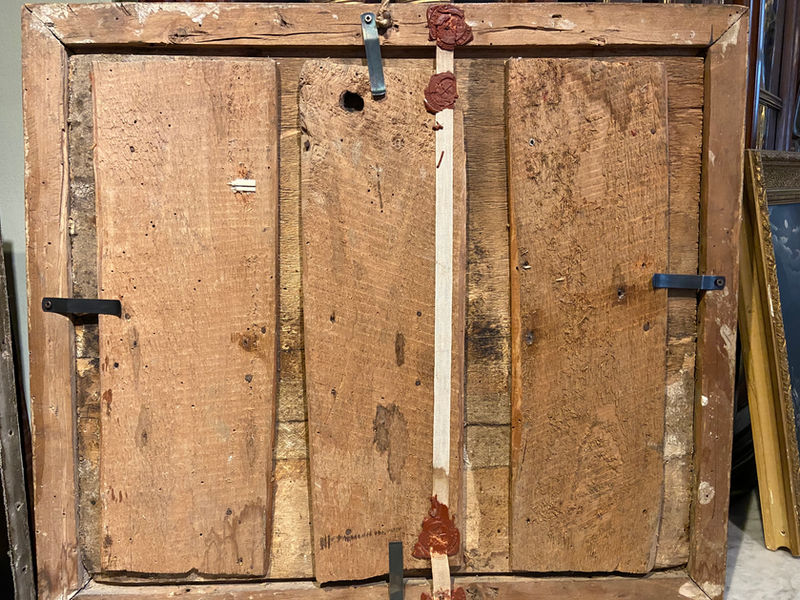
Attributed to Fedele Fischetti (Napoli, 1732 - 1792)
The Rape of Europa (Ratto di Europa)
Oil on wood panel with gold leaf
Size: 53.5cm x 45.5cm (panel); 60.5cm x 53.5cm (frame)
This picture is a beautiful work of eighteenth-century, Neapolitan rococo art: a testament to an age of decorative refinement, ornate elegance, and playful classicism. The mythical (and racy) subject - the abduction and subsequent rape of Europa by Zeus disguised as a bull - is offset by a burnished, gilt background. The gold-leaf dominates the picture with a tone of celebratory richness; it is decorative even to the point of distraction. Yet Europa's abduction is shrouded with this playful ambiguity too; her maiden-attendants agitate their arms with dramatic alarm, but Europa's singular, raised hand is more of a composed wave (a resigned goodbye or a desperate grasp towards the receding shore?). Not to mention how Europa and the bull are crowned with garlands that suggest a celebratory frivolity - like a newlywed couple prancing away during Mayday festivities rather than the despairing, ravished maiden of Titian's famous exemplar. And where Titian has his Europa frantically wave a blood-red scarf in the air, our Europa's sky-blue shawl elegantly unfurls into the gold-leaf background, creating a beautiful, decorative contrast of rich colours. The emphasis here is on elegant play.
The gallerist in Florence is adamant in his attribution of the painting to Fedele Fischetti (Naples, 1732 - 1792). The picture does certainly share many similarities with Fischetti's work and is distinctly from the golden age of neoclassical rococo in eighteenth-century Naples. Paintings in this period were intimately linked with material decoration: The Rape of Europa likely adorned the gilded, wooden panels on a piece of furniture such as a room screen, a cabinet, a sedan chair, or even a chariot door.
Provenance and Condition:
Fischetti's originally decorative purpose here finds new life when repurposed in a framed setting. That dichotomy between serious, thematic subject and trivial ornamentation so inherent to the rococo ethos is now thrown in even sharper relief. And although the wooden panel has suffered significant deterioration, the dotted flecks of crumbling gold-leaf add an element of nostalgic charm to the picture: there is a delicate airiness to the foliage permeated by the craquelure of the gilding; the vibrancy of the colours are only enhanced by the visibly sandy texture of the gold-leaf.
The picture also originates from the Gerini Villa, though it is in worse condition than the Venetian Landscape and must have travelled more in its past. Yet this beat-up quality does not occlude the brilliance of the painting's composition and design; part of the attractiveness of this painting is its physical materiality. What remains is a work of art that exists somewhere between an object as decorative ornament and a painting as aesthetic study.


